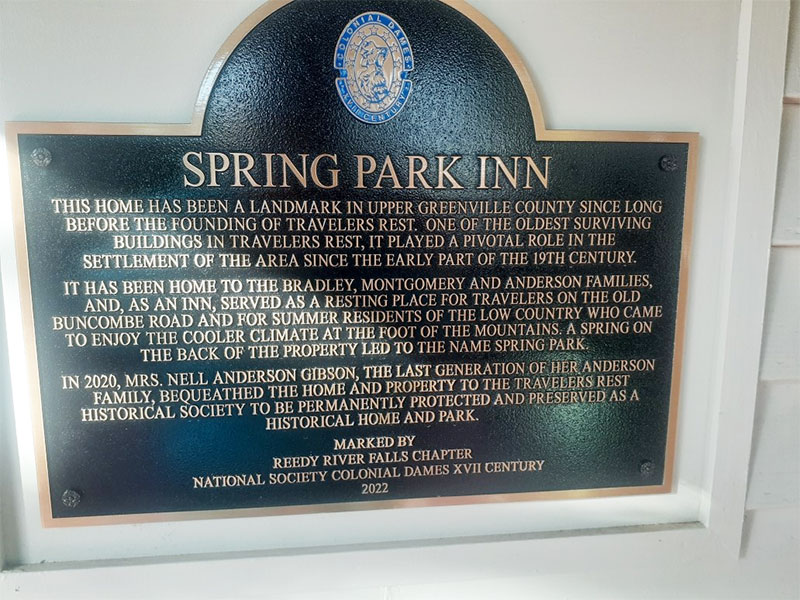- Revisiting the Great Work of Medical Missionary Dr. Anne Livingston in Haiti
- Dick Cheney Was a Great Boss
- "I Beat Hitler!"
- Christmas Season in Western North Carolina
- 2026 US Senate Race in North Carolina
- The Fall of Man: John Calvin, Leibniz, and Deeper Truths
- Time of Reassessment America
- Has the Bethlehem Star Mystery Been Unveiled?
- Appeals Court Refuses to Dismiss Greenville County Republican Chairman’s Contempt Case
- The America That Once Was (A Christmas Memory)
- Is a Self-Proclaimed Drag Queen Performer Serving in a Leading Moral Arc Role at a Greenville Children’s Production of Annie?
- Merry Christmas from Times Examiner
- Project Ukraine and Ukrainian/CIA Intelligence
- Republican Women's Club Hosts Freedom Caucus Members
- The Trump 2025 National Security Strategy
Historical
Dedication of an Historical Marker at the Spring Park Inn in Travelers Rest
- Details
- By Terry M. Thacker

About three dozen history enthusiasts attended the dedication of this historical plaque in Travelers Rest.

The Spring Park Inn in Travelers Rest. The inn, over 200 years old, was recently donated to the Travelers Rest Historical Society.
The Last Words, The Farewell Addresses of Union and Confederate Commanders to Their Men at the End of the War Between the States
- Details
- By Gene Kizer, Jr., Charleston Athenaeum Press
 [Publisher's Note, by Gene Kizer, Jr. : In the past few weeks, we have expanded our distribution network to include, not only Amazon, but the Ingram Book Company, the largest wholesale book distributor in the world. We'll be in select bookstores, libraries, universities (they NEED it!) and retail outlets - bricks and mortar, and online - worldwide. We are extremely proud to announce that historian Michael R. Bradley's outstanding new book, The Last Words, The Farewell Addresses of Union and Confederate Commanders to Their Men at the End of the War Between the States, is our first title on both Ingram and Amazon and is now also available here on our website as an ebook, softcover and hardback.
[Publisher's Note, by Gene Kizer, Jr. : In the past few weeks, we have expanded our distribution network to include, not only Amazon, but the Ingram Book Company, the largest wholesale book distributor in the world. We'll be in select bookstores, libraries, universities (they NEED it!) and retail outlets - bricks and mortar, and online - worldwide. We are extremely proud to announce that historian Michael R. Bradley's outstanding new book, The Last Words, The Farewell Addresses of Union and Confederate Commanders to Their Men at the End of the War Between the States, is our first title on both Ingram and Amazon and is now also available here on our website as an ebook, softcover and hardback.
When Dr. Bradley first approached me with the idea for The Last Words, I immediately knew it would be an important book in this day and age of nauseating politicized historians and journalists whose idea of historical truth comes from the New York Times and Communist Manifesto.
“Challenge Accepted!” Chautauqua History Comes Alive Festival
- Details
- By Caroline McIntyre
June 9 – 19, 2022

Eisenhower, Houdini, Kennedy, O’Keeffe and Murray - brilliant Americans who stepped up to accept the challenges of their lifetimes. Their influence spanned the arts of war, politics, painting, social protest, and even deception. Hear their stories – ask them how their world changed – and why they accepted the gauntlet.
WHO: A cast of nationally acclaimed historical interpreters will perform in character. (Performer Bios below)
- Dwight Eisenhower – General and President (Portrayed by Doug Mishler, Reno, NV)
- Harry Houdini – Magician and Skeptic (Portrayed by Larry Bounds, Greer, SC)
- Robert Kennedy – Politician and Attorney General (Portrayed by Jeremy Meier, Sylvania, OH)
- Georgia O’Keeffe – On Canvas and Off (Portrayed by Leslie Goddard, Chicago, IL)
- Pauli Murray – Attorney and Priest (Portrayed by Becky Stone, Fairview, NC)
WHAT: A ten-day, two-weekend festival offering entertaining historically accurate storytelling. Get ready to travel in time and interact with these famous Americans, where secrets will be revealed. You’ll laugh, cry and flat out have a great time. And the shows are FREE! (Nominal fee in Asheville.)
A Black History Plea for Justice and Unity
- Details
- By Alveda C. King
Dear America, we are over halfway through Black History Month 2022. I am writing today with a plea for prayers of love, unity, righteousness, justice, and law and order; first in our nation, and then around the world.
In light of controversial current events such as trucker protests, critical race theory debates, China challenges, and political jockeying over crack pipes, (https://www.foxnews.com/opinion/biden-administration-black-americans-alveda-king-jack-brewer-ken-blackwell) I believe it's time to pause and take a prayer break.
Thankfully, in spite of controversial news reports, natural and man made disasters, and all types of mayhem, there is quite a bit of positive attention being given to the subject of black history this year.
The Four Declarations of Causes for Secession Do Not Prove the War Was Fought Over Slavery
- Details
- By Gene Kizer, Jr., Charleston Athenaeum Press
ACADEMIA'S ABSOLUTE PROOF that the War Between the States was fought over slavery is based primarily on the declarations of causes for the secession of four of the first seven Southern states to secede: South Carolina, Georgia, Mississippi and Texas.
However, those four declarations prove nothing of the sort.
There were 13 Southern states represented in the Confederate government. That 13 included Missouri and Kentucky, which were divided states that did not actually secede. They remained Union slave states - two of six Union slave states - the entire war (WHAT! UNION SLAVE STATES! I thought the war was fought over slavery with the Union fighting to end slavery! Man, they should have started with their own country).
In fact, three of the six Union slave states - New Jersey, Kentucky and Delaware - had slavery several months after the war. It took the second 13th Amendment in December 1865 for slavery to end in those three Union slave states.
Black History and Human Dignity for Life
- Details
- By Alveda King
"Injustice anywhere is a threat to justice everywhere." Rev. Dr. Martin Luther King, Jr.
February is "Black History Month" in America. In commemoration, we are "boots on the ground" today with a visit to the Civil Rights Museum in Jackson, Mississippi. Jackson is also the seat of the Dobbs v. Jackson Women's Health Organization pending U.S. Supreme Court case dealing with the constitutionality of a 2018 Mississippi state law that banned abortion operations after the first 15 weeks of pregnancy.
We visit America's "Black History" today with hope ever rising in our hearts, for the human dignity of all Americans and all humanity, from the womb to the tomb, as we pray to end the injustices that sadly have taken place on the soil of our own country.
Slaughter at Cainhoy, The Worst Racial Violence in the South Carolina Lowcountry During Reconstruction, Part Two, Conclusion
- Details
- By Gene Kizer, Jr., Charleston Athenaeum Press

THE RECORD OF JOINT MEETINGS in the Charleston area had been good in spite of the Charleston riot of September 6th. There had been a joint meeting at Strawberry Ferry and successful joint meetings "on Johns Island, on Edisto Island and at other points." Nobody was suspecting trouble when a joint meeting was scheduled for "Brick Church, about three miles from Cainhoy, in the parish of St. Thomas and St. Dennis," to take place Monday, October 16, 1876.1
Democrats chartered the steamer Pocosin which left that morning with around 150 men on board including many black Democrats. At the last minute word was sent that Republican leader Bowen wanted to ride, and the steamer waited until he was aboard with 150 black Republicans including "McKinlay, Cyrus Gaillard and other prominent speakers."2
- Slaughter at Cainhoy, The Worst Racial Violence in the South Carolina Lowcountry During Reconstruction, Part One
- "Little Short of a Miracle!" Constitution Day, Sept 17
- America Celebrated 234th Constitution Day
- The "Pledge of Allegiance"
- A Visitor from the Past
- We Mean to WIN this Heritage War
- Secession, North and South
















